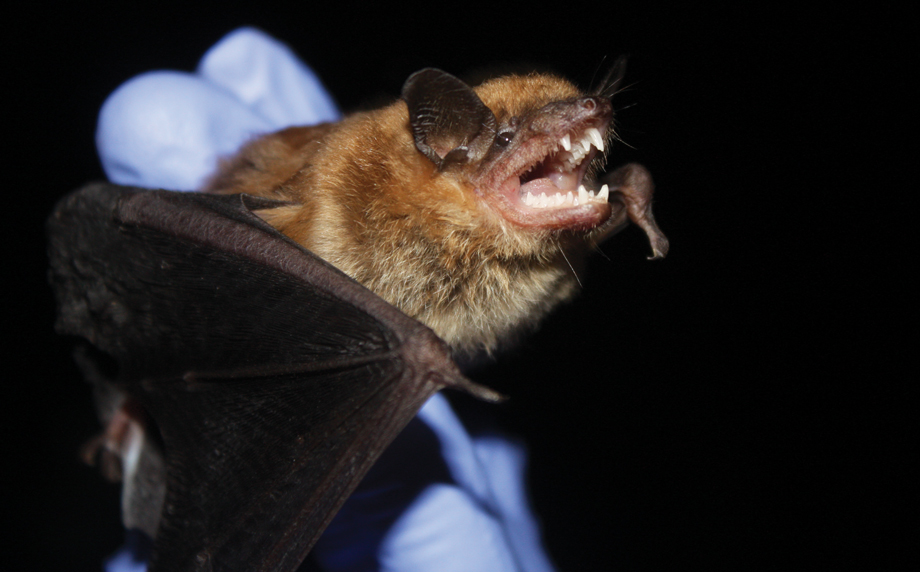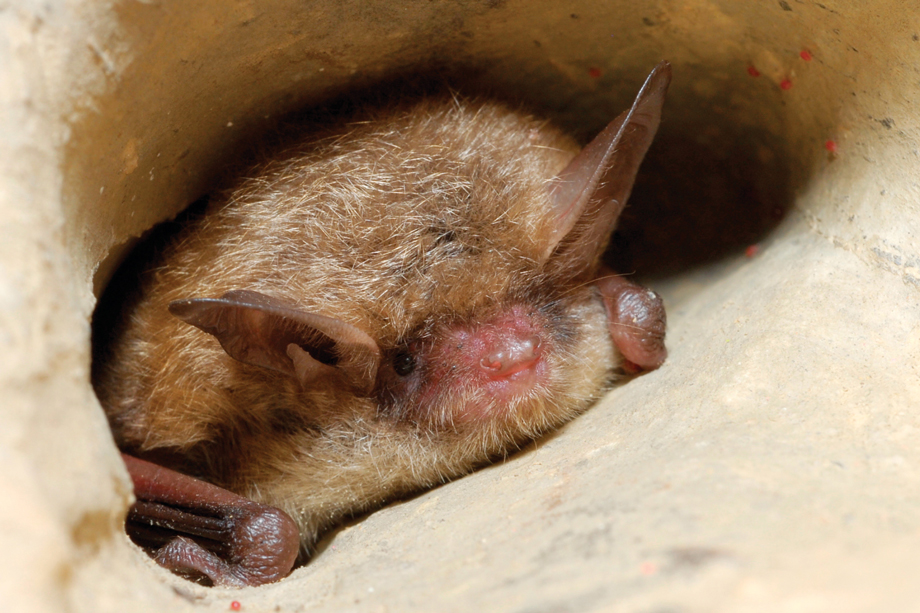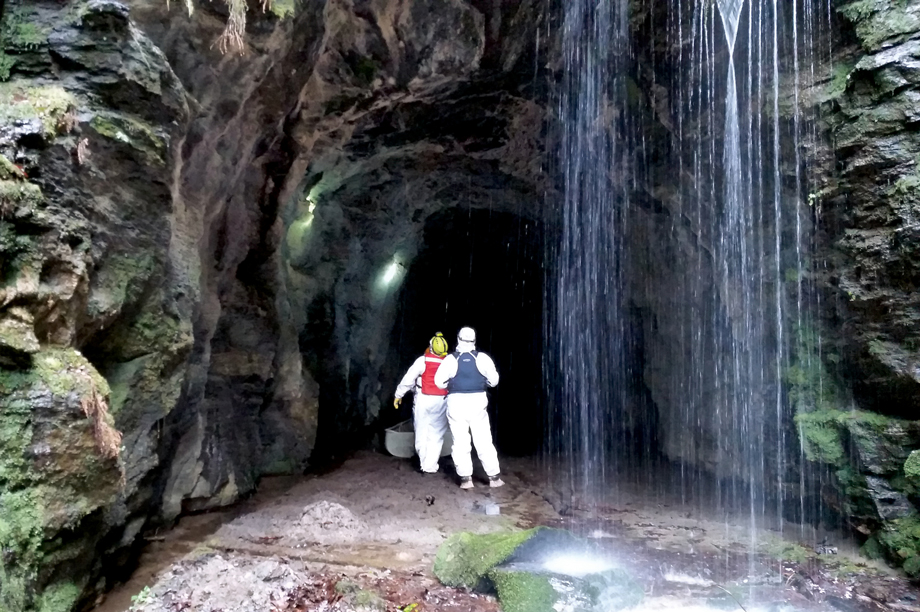
Bats are warm and fuzzy, which hasn’t stopped us from treating them with a cruelty that borders on the baroque. Over the centuries, bats have been shot, gassed, burned, electrocuted, drowned, bludgeoned, stoned, poisoned, and blown up. On the day after Christmas in 1960, at Carter Caves State Park in Kentucky, three boys ripped hibernating bats from the walls and ceiling of a cave and then trampled them. Ten thousand were dispatched that way, according to a global examination of bat deaths published last year in the journal Mammal Review. In Laos, bats roosting in palm trees were killed by young men who waited until dusk to take them down—with slingshots. In Gibraltar, youths smoked out a colony of 5,000 bent-wing bats, then proceeded to kill them. (It’s not clear how.) Over the winter of 1941, boys in Minnesota lit newspapers on fire near hibernating bats, burning them to death.
In some corners of the world, bats are less a nuisance than they are dinner. In 1917, scientists in Congo observed the Mangbetu people’s method for cooking the free-tailed bat: “Spiked on a splinter of wood, singed and broiled over the fire, the bowels left in as a condiment but pressed out just before serving, make them choice morsels.” It was a delicacy fit for a king—literally—provided the teeth, sharp as needles and thought to cause internal bleeding if ingested, were removed first. “They make a very welcome present, but should one forget to break out their needles he would be guilty of the gravest offense. Suspected of an intention to murder the king, his days would be numbered.”
No matter the culture, bats are freighted with a supernatural significance that reduces this complex and intelligent animal to a symbol (in China, five bats represent five blessings) or an omen (Dracula, death), which only distracts from truly understanding them.
As it happens, humans are most lethal to bats by accident. “We are part of the problem,” wrote Charles Mohr, a naturalist with the state of Delaware, in the April 1972 edition of the Bulletin of the National Speleological Society. Who is “we”? Name it. Spelunkers who disturbed roosting bats’ hibernacula; well-intentioned but clumsy scientists who mishandled the animals; developers who destroyed bat habitats; and farmers who used insecticide, specifically DDT, on their crops. We may have since banned DDT, but we’ve come up with something just as fatal to bats: wind farms. A bat typically weighs less than an ounce; a turbine blade, up to 12 tons. Do the math. The ground around many wind farms is essentially a bone yard for bats.
But nothing—not chemicals, nor wind farms, nor sadistic teenage boys—has wreaked the kind of havoc on the bat population as has white-nose syndrome, a disease that is killing bats by the millions. First identified in 2007 in upstate New York, the plague has crept inexorably outward, blighting caves one by one, an ever-expanding vector of obliteration. There are two ways scientists know when white-nose syndrome has colonized a cave: when bat carcasses carpet the floor or when the bats, normally clutching the cave walls, are simply gone.

Photograph by Pete Pattavina
The culprit couldn’t be more ordinary: a simple fungus that thrives in confined and cool spaces. But the fungus that causes white-nose is not native to North America. Rather, it was transported here, probably unintentionally, probably from Europe, maybe on the bottom of a caver’s boot. European bats, over eons, developed a resistance to the fungus, evocatively named Pseudogymnoascus destructans. But bats in North America were as equipped to fight it as a parade of ants is against a can of Raid. The fungus creeps across the muzzles of bats while they hibernate, giving the disease its name. It permeates their wings, sometimes eating holes into the membranes. It wakes them early from their torpor, sending some of them out of their caves into the cold of winter, where there’s no food and their fat reserves are quickly depleted. Weakened, their immune systems compromised, the bats fall from the sky. Others simply tumble from their roosting perches.
Here in Georgia, officials knew it was only a matter of time before white-nose syndrome penetrated our northern borders. But forewarned wasn’t forearmed. For the researchers and scientists who devote their professional lives to studying the 16 species of bats in Georgia—who understand the bats’ critical role in our ecology, who know there is no better friend to farmers than insect-eating bats, who crawl into caves every winter to conduct bat counts, who marvel at their social structure—the die-off, when it was first spotted here a few years ago, felt deeply personal.
Jacalyn Beck, bat research coordinator with the Georgia Department of Natural Resources, recalled an especially gruesome scene in a cave in northwest Georgia in 2015. “I remember smelling the dead bats before I even saw them. Where once there were thousands of bats there were now a few hundred. The amount of fungus was something that I had never seen, ever, and I had to stop. My boss came to me, and we just stood there with our arms around each other. It’s hard to internalize when this is your job, this is what you do every day, what you put your heart into. It’s not just papers or numbers. These are living things, and to see them drop dead in front of your eyes . . .”

Photograph by Steve Fennessy
I met Beck on a Thursday night in June on the Old John Ward Road Trail, a dirt path that cuts through the forest of the Kennesaw Mountain National Battlefield Park. With her was Anthony Winegar, the park’s chief ranger, and Sarah Gorton, a 19-year-old student at the University of Texas at San Antonio and a technician at the University of Georgia, who was helping with bat research for part of the summer. Gorton wore a shirt that read, “My bat is smarter than your honor student.” Last year Gorton raised $800 in an online campaign to help pay for rabies vaccinations that would allow her to work with bats worry-free.
There are dog people, cat people, horse people, snake people, bird people. Then there are bat people, who take a special pleasure in debunking various misconceptions about bats. Rabies, for one. Bats can carry rabies, but, according to the CDC, only 6 percent of those turned in by the public for testing—in other words, those that were captured, or found sick or injured—are positive for rabies. Among the overall bat population, it’s thought that fewer than 1 out of 100 is carrying the virus. From 2003 to 2014, 30 Americans died of rabies. Of those, 12 died as a result of direct contact with a rabid bat.
Vampire bats, which aren’t even found in the U.S., tend to color the public’s perception of all bats. Misperceptions, actually, if you ask Gorton, who volunteers at the San Antonio Zoo back home.
“Vampire bats are my favorites because people are like, ‘Oh gross, vampire bats. They drink your blood.’ But first of all, they’re really cute. They’ve got these little piggy noses. Second of all, they’re exciting because they can actually run, and there’s only a couple other species of bats that can be on the ground and move.”
As Gorton spoke, Beck clutched in her gloved hands a big brown bat that had flown into one of the two mist nets the women had erected along the trail, spanning the trail’s width and climbing 20 feet into the tree canopy. Mist nets are expanses of mesh that look like something you’d find on a volleyball court. The nets are used to capture bats after dark, so that researchers can gauge the health of the population. The big brown bat was the second Beck had netted that night. Beck and Gorton were checking their nets every 10 minutes; any less often and a bat caught up in the net might have time to chew itself out. This particular bat was less than an ounce—pretty typical. Beck shined a light through the bat’s wings, checking for fungal spots. It was clean. Although the white-nose fungus retreats during warmer temperatures, bats that have fought the disease can show scarring on their wings. As she turned the bat in her hands, its teeth clamped down on Beck’s finger, but didn’t break through the glove. Big brown bats can live up to 20 years, and females produce just one or two pups a year, as this one recently had, Beck determined.
“I’m trying to feel her up. She’s lactating. She’s got a little tummy, but she’s full. She’s been eating all night, but she’s got these big old exposed nipples because her pup is nursing right now.”
“Wow, like a human?” asked Winegar.
“Yep,” said Beck. “In their armpits. Tucked up in there.”
“Like a bad L.A. boob job.”
Beck grinned. “Don’t listen to him. You are beautiful. You’re just as you’re supposed to be. Don’t let anyone tell you otherwise.” The bat fidgeted and squeaked in Beck’s hands. Beck held the bat above her head, loosened her grip, and the animal flapped off.

Photograph by Steve Fennessy
Gorton resumed her vampire bat testimonial. “They bite whatever they’re going to be drinking blood out of, which is usually like a cow or an ostrich—depends on the bat—and there’s an anticoagulant in their saliva that keeps it flowing.” Draculin, as it’s called, is even being developed into a drug to help stroke patients.
At the San Antonio Zoo, Gorton explained, she frames her pitch about bats in relatable terms: grocery bills and tequila.
“Bats eat up to a billion dollars plus in pests every year, which saves you money on groceries because farmers are using less on pest control. Also bats are the only pollinators of the agave cactus, where tequila comes from. So no bats, no tequila. Between those two things, people are like, ‘Oh, I love bats now.’”

Photograph by Pete Pattavina

Photograph by Pete Pattavina
Black Diamond Tunnel, in Rabun County, was originally supposed to be part of a train route that connected North Georgia to Charleston. But the Civil War interrupted construction, and over time bats began using it as a winter refuge. In 2013 it housed 5,517 tricolored bats, thought to be the biggest colony of their kind in Georgia. Particularly sensitive to the cold, tricolored bats, so named because each hair is divided among three shades, are among the first to hibernate in the fall and among the last to emerge in the spring. They often hibernate in clusters and tend to return to the same cave year after year. In other words, they’re an ideal target for Pseudogymnoascus destructans. In 2014, after the fungus hit, the annual survey of Black Diamond Tunnel revealed just 3,472 bats; the next year, it was down to 500. This year’s count, conducted on March 1, turned up just 220 bats. The fungus had wiped out 95 percent of the population. Black Diamond Tunnel is considered post-collapse.
Participating in this year’s count was Dr. Chris Cornelison, a 31-year-old microbiologist from Georgia State University. Cornelison grew up in East Cobb, and as part of his doctoral work at Georgia State, he’d been studying ways to reduce the spread of mold inside buildings. When white-nose syndrome was identified, and it became clear that the disease was heading down the Appalachian range toward Georgia, Cornelison saw an opportunity to change tack.
“The mortality rates were just completely unprecedented, so it was very clear that it was a dire situation,” he told me in the office of his lab on the third floor of the university’s Natural Science Center on Decatur Street. “The fungus had just been discovered, and nobody really knew anything about it.”
Cornelison was familiar with the work being done in the lab next to his, where Dr. George Pierce, another microbiologist, was researching how to prolong the shelf life of fruits. Pierce had patented a strain of Rhodococcus rhodochrous, which is a naturally occurring bacterium in soil. This particular strain was found to inhibit the development of mold on fruit. Perhaps most intriguing, though, was that the bacteria didn’t even have to physically touch the mold to stop its growth; they needed only to share air space with it.
Cornelison had seen photographs of bats affected with white-nose syndrome, and the fungus coating their muzzles didn’t look all that different from a mold you might see growing on the stem of a banana. “I was seeing these two images, and it looked the same. From the fungus’s perspective, it doesn’t know a bat is a bat. It doesn’t know a banana is a banana. It sees both of them, essentially, as decaying organic matter—a food source—so it reacts the same. If you can use a technology to prevent it from growing on the stem of a banana, then on a very fundamental basis, it’s the same concept as keeping it from growing on the snout of a bat.”

Photograph by Gregory Miller
Even though the white-nose fungus was altogether different from the kind that grows on fruit, Cornelison wondered if it might also be susceptible to Rhodococcus rhodochrous. “I had the freedom, as a graduate student, to pursue crazy ideas that nobody should waste their time on because why would that work? That’s the beauty of academia, that you have this freedom to explore ideas that might be on the fringe and might be unusual and abnormal. But sometimes they work out.”
And this one did: When a Petri plate of the fungus shared a confined space with the bacteria, the chemicals emitted by the bacteria not only stopped the fungus from growing, they killed it. In a paper he authored, Cornelison wrote that the discovery was a “major milestone” in the search for a biological weapon against the fungus that causes white-nose syndrome.
The next step was to see if the bacteria could work on affected bats. In late fall of 2014, at four sites in Kentucky and Missouri, researchers went into caves and collected bats—hundreds of them, across the four locations—that displayed the fungus. As many as 50 bats at a time were placed into 72-quart coolers, each of which also contained two Petri plates of the bacteria. The researchers closed the lids and left them there for 48 hours, then removed the bats and put them into enclosed cages within the caves—enclosed so that researchers could isolate them until spring and also protect them from predators.
The results were encouraging. In some cases, groups exposed to the bacteria saw survival rates that were 70 percent greater than those of control groups that weren’t treated. (Specific results haven’t been released yet.) But as successful as the treatment may prove, it can’t be applied on a large scale; there are simply too many caves—as many as 10,000 in Tennessee alone, almost 1,000 in Georgia—and not enough time. Likewise, researchers studiously avoid the word cure; they speak instead of disease management. Cornelison’s team is working to modify a medical nebulizer, a misting device, that they’ll send into Black Diamond Tunnel, where it will emit a vapor containing a natural fungicide. The hope is that any white-nose fungus will be knocked back enough to pose a lesser threat to the bats when they return to hibernate. A second, weaker dosing could take place while the bats are hibernating.
But all of these measures are stopgaps. “If you really want to turn the tide of white-nose syndrome, and change the disease dynamic over a continent, you need something more permanent, like a vaccination,” Cornelison said. “But that’s not available now. And the worry is, if we continue to lose 95 percent of bats, by the time a vaccine is available, there’ll be no bats left to vaccinate.”

Photograph by Kyle Gabriel
Black Diamond Tunnel floods, and so researchers conduct their bat counts from a john boat. At times the water level is so high there’s just a few feet of clearance to the ceiling. As the boat glides deeper into the 1,400-foot-long tunnel, the researchers are forced to lie on their backs in the boat. It’s not an errand for the claustrophobic. Before white-nose syndrome arrived, counting duties were divided three ways: one tallied bats on the left, one on the right, and one overhead. Each would use a handheld clicker to track the count.
“You’d hear clickclickclickclickclickclick all the way to the end, and we’d count 5,000 bats,” Beck said.
“Now, you’re sitting in a boat and someone asks, ‘Hey, did you get that one?’ Click.” She paused a beat. Two beats. “Click.”
For Cornelison, the count this past March was not just a chance to size up the cave in preparation for spraying it, it was also an opportunity to see the effects of white-nose at its most visceral. The boat brushed past floating dead bats, their remains slicked with the fungus. Other bats were alive, still in hibernation, but visibly infected. “At that point,” Cornelison said, “you know where it’s going.”
Even if the spread of white-nose was somehow curbed tomorrow, no one alive today would live long enough to see the most decimated species return to the numbers seen before the disease. Bats, who produce just one or two offspring a year, simply aren’t fecund enough to rebound anything but slowly. It’s too soon to say what the agricultural impact will be, but corn farmers in particular are watching the die-off closely. Bats can consume their body weight in insects each night, and one of their favorite meals is the Helicoverpa zea moth, whose larvae, the corn earworm, can destroy a corn crop. With fewer bats to eat the moths, farmers will likely have to spray more pesticides. Likewise, fewer bats means more mosquitoes. One Long Island town, concerned about the threat of mosquitoes spreading West Nile and Zika viruses, is even building bat houses to attract more of the animals.
On March 11, hikers found a sick bat on a trail 30 miles east of Seattle. They took it to a rescue group, which passed it on to federal officials, who confirmed it had white-nose syndrome. It was the first documented case of the disease west of the Rockies. Up to then, the disease had spread in a predictable pattern, moving incrementally south and west from New York. Before March the farthest west that white-nose had been identified was in Minnesota. The discovery in Washington would indicate the disease had jumped 1,500 miles. It shows no sign of slowing down.
This article originally appeared in our August 2016 issue.










![The North Carolina Museum of Natural Sciences’ newest exhibit is a [pre]historic first](https://cdn2.atlantamagazine.com/wp-content/uploads/sites/4/2024/04/DD-3-100x70.jpg)



